sunroof MITSUBISHI ECLIPSE CROSS 2020 Owner's Manual (in English)
[x] Cancel search | Manufacturer: MITSUBISHI, Model Year: 2020, Model line: ECLIPSE CROSS, Model: MITSUBISHI ECLIPSE CROSS 2020Pages: 427, PDF Size: 78.05 MB
Page 9 of 427

Interior 1-5 Overview
1
Assist grips P.5-225 Coat hook P.5-226
Bottle holder P.5-223
Head restraints P.4-9
Arm rest (if so equipped) P.4-8 Rear drink holder (if so equipped) P.5-223
Cargo area cover (if so equipped) P.5-223
Supplemental Restraint System (SRS) - curtain airbag P.4-30, 4-41 Dome light (rear) P.5-219
Front shade switch (if so equipped) P.5-46
Dome light (front) switch P.5-218
Front sunroof switch (if so equipped) P.5-46
Dome light (front)/Reading lights P.5-218
Hands-free microphone (if so equipped)
Dome light (front)/Reading lights P.5-218
Telematics Control Unit (TCU) (if so equipped) P.3-5
Rear shade switch (if
so equipped) P.5-46
BK0277700US.bo
ok 5 ページ 2019年3月8日 金曜日 午前9時23分
Page 11 of 427
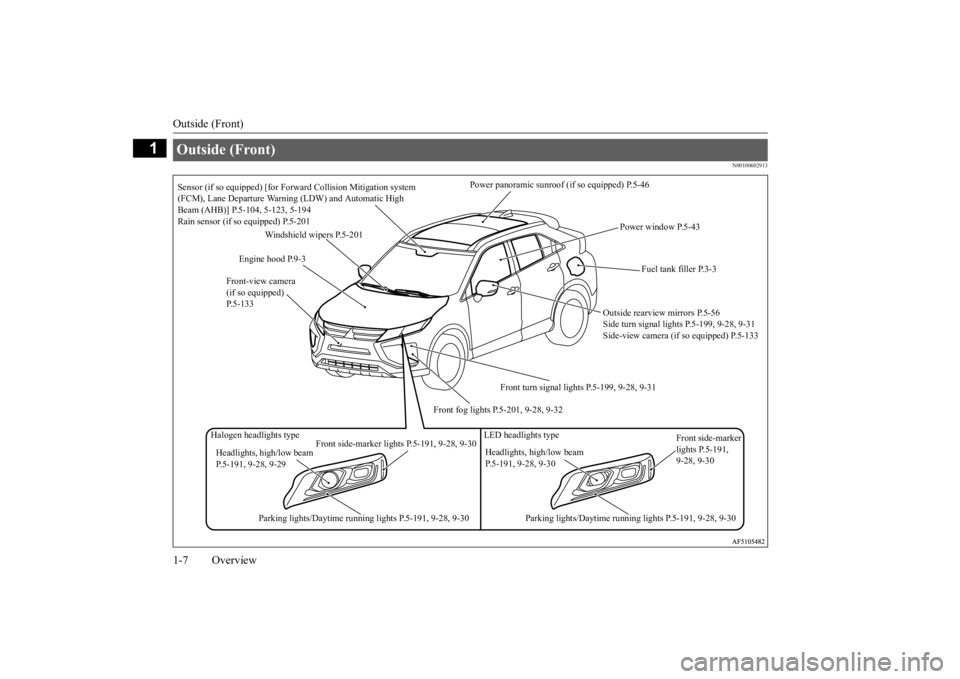
Outside (Front) 1-7 Overview
1
N00100602913
Outside (Front)
Power panoramic sunroof
(if so equipped) P.5-46
Windshield wipers P.5-201
Engine hood P.9-3
Front fog lights P.5-201, 9-28, 9-32
Outside rearview mirrors P.5-56 Side turn signal lights P.5-199, 9-28, 9-31Side-view camera (if so equipped) P.5-133
Fuel tank filler P.3-3
Power window P.5-43
Front turn signal lights P.5-199, 9-28, 9-31
Headlights, high/low beam P.5-191, 9-28, 9-29
Headlights, high/low beam P.5-191, 9-28, 9-30
Parking lights/Daytime running lights P.5-191, 9-28, 9-30
Parking lights/Daytime running lights P.5-191, 9-28, 9-30
Halogen headlights type LED headlights type
Front side-marker lights P.5-191, 9-28, 9-30
Front side-marker lights P.5-191, 9-28, 9-30
Sensor (if so equipped) [for Fo
rward Collision Mitigation system
(FCM), Lane Departure Warn
ing (LDW) and Automatic High
Beam (AHB)] P.5-104, 5-123, 5-194 Rain sensor (if so equipped) P.5-201
Front-view camera (if so equipped) P.5-133
BK0277700US.bo
ok 7 ページ 2019年3月8日 金曜日 午前9時23分
Page 127 of 427

Power panoramic sunroof (if so equipped) 5-46 Features and controls
5
N00551400043
Wind buffeting can be described as the per- ception of pressure on the ears or a booming or rumbling sound. Your vehicle may exhibit wind buffeting when driving with one or bothrear door windows down or partially opened. This is a normal occurrence that can be mini- mized. If the buffeting occurs with the reardoor windows open, open the front door win-dows as well as the rear door windows to minimize the condition.
N00594700036
The front sunroof & front shade can be opened or closed with the ignition switch in the “ON” position or the operation mode in ON.
What to do if you hear wind buffeting when driving Power panoramic sunroof
(if
so equipped)
WA R N I N G Do not put head, hands or anything else out of the front sunroof opening whiledriving the vehicle. Never leave children or unreliable adults unattended inside the vehicle. Never leave the vehicle without carrying the key. Before operating the front sunroof, front shade, or rear shade, make sure that noth- ing is capable of being trapped (head,hands, fingers, etc.) in the front sunroof, front shade, or rear shade.
Because the front sunroof opens to the outside of the vehicle, do not open the sun- roof when cleaning the top of the roof, etc. Your hands or arms could be trapped.NOTE
When leaving the vehicle unattended, be sure to close the front sunroof and carry thekey. Do not try to operate the front sunroof if it is frozen closed (after snow fall or during extreme cold). Do not sit or place heavy luggage on the front sunroof or roof opening edge. Do not apply any force that may cause dam- age to the sunroof. Release the switch when the front sunroof, front shade, or rear shade starts to move. If the front sunroof, front shade, or rear shade does not operate when the switch is operated, release the switch and checkwhether something is trapped by the sunroof or shade. If nothing is trapped, we recom- mend you to have the sunroof or shade checked at an authorized Mitsubishi Motors dealer. Be careful when tilting up the front sunroof if a ski carrier or a ro
of carrier is installed.
Depending on the model of ski carrier or roof carrier, the front sunroof may contact the car- rier when the front sunroof is tilted up.WA R N I N G
Be sure to close the front sunroof completely when washing the vehicle or when leaving the vehicle. After washing the vehicle or after rain be sure to wipe off any water that is on the front sunroof before operating it. Operating the front sunroof, front shade, or rear shade repeatedly with the engine turned off will run down the battery. Operate thefront sunroof, front shade, and rear shade only while the engine is running.
Front sunroof & front shade
NOTE
BK0277700US.bo
ok 46 ページ 2019年3月8日 金曜日 午前9時23分
Page 128 of 427
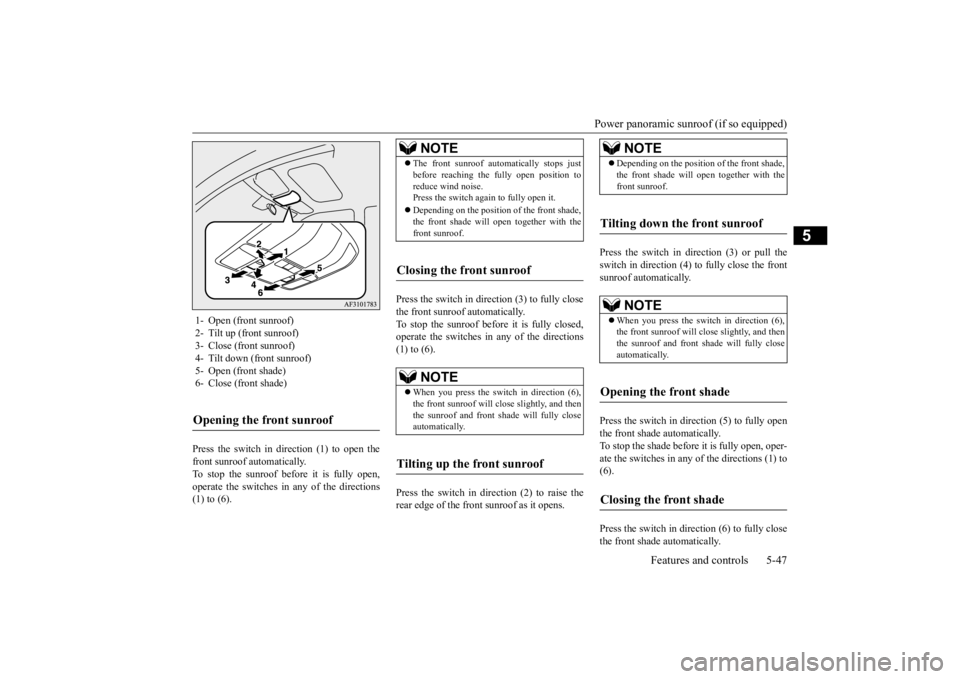
Power panoramic sunroof (if so equipped)
Features and controls 5-47
5
Press the switch in direction (1) to open the front sunroof automatically. To stop the sunroof before it is fully open, operate the switches in any of the directions(1) to (6).
Press the switch in direction (3) to fully close the front sunroof automatically. To stop the sunroof before it is fully closed, operate the switches in any of the directions(1) to (6). Press the switch in direction (2) to raise the rear edge of the front sunroof as it opens.
Press the switch in direction (3) or pull the switch in direction (4) to fully close the frontsunroof automatically. Press the switch in direction (5) to fully open the front shade automatically. To stop the shade before it is fully open, oper- ate the switches in any of the directions (1) to(6). Press the switch in direction (6) to fully close the front shade automatically.
1- Open (front sunroof) 2- Tilt up (front sunroof) 3- Close (front sunroof) 4- Tilt down (front sunroof)5- Open (front shade) 6- Close (front shade)Opening the front sunroof
NOTE
The front sunroof automatically stops just before reaching the fully open position to reduce wind noise. Press the switch again to fully open it. Depending on the position of the front shade, the front shade will open together with the front sunroof.
Closing the front sunroof
NOTE
When you press the switch in direction (6), the front sunroof will cl
ose slightly, and then
the sunroof and front shade will fully close automatically.
Tilting up the front sunroof
NOTE
Depending on the position of the front shade, the front shade will open together with the front sunroof.
Tilting down the front sunroof
NOTE
When you press the switch in direction (6), the front sunroof will cl
ose slightly, and then
the sunroof and front shade will fully close automatically.
Opening the front shade
Closing the front shade
BK0277700US.bo
ok 47 ページ 2019年3月8日 金曜日 午前9時23分
Page 129 of 427
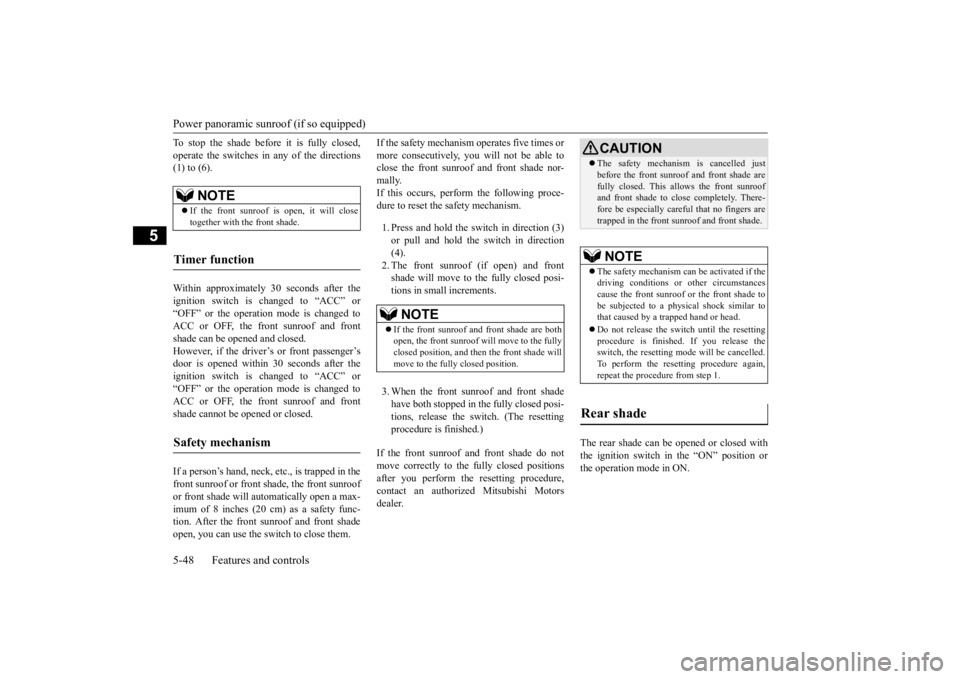
Power panoramic sunroof (if so equipped) 5-48 Features and controls
5
To stop the shade before it is fully closed, operate the switches in any of the directions (1) to (6). Within approximately 30 seconds after the ignition switch is changed to “ACC” or“OFF” or the operatio
n mode is changed to
ACC or OFF, the front sunroof and front shade can be opened and closed.However, if the driver’s or front passenger’s door is opened within 30 seconds after the ignition switch is changed to “ACC” or“OFF” or the operatio
n mode is changed to
ACC or OFF, the front sunroof and front shade cannot be opened or closed. If a person’s hand, neck, etc., is trapped in the front sunroof or front sh
ade, the front sunroof
or front shade will au
tomatically open a max-
imum of 8 inches (20 cm) as a safety func- tion. After the front sunroof and front shadeopen, you can use the switch to close them.
If the safety mechanism operates five times or more consecutively, you will not be able to close the front sunroof and front shade nor- mally.If this occurs, perform the following proce- dure to reset the safety mechanism. 1. Press and hold the switch in direction (3) or pull and hold the switch in direction(4). 2. The front sunroof (if open) and front shade will move to the fully closed posi-tions in small increments. 3. When the front sunroof and front shade have both stopped in the fully closed posi- tions, release the switch. (The resetting procedure is finished.)
If the front sunroof and front shade do not move correctly to the fully closed positions after you perform the resetting procedure, contact an authorized Mitsubishi Motorsdealer.
The rear shade can be opened or closed with the ignition switch in the “ON” position or the operation mode in ON.
NOTE
If the front sunroof is open, it will close together with the front shade.
Timer function
Safety mechanism
NOTE
If the front sunroof and front shade are both open, the front sunroof will move to the fullyclosed position, and then the front shade will move to the fully closed position.
CAUTION The safety mechanism is cancelled just before the front sunroof and front shade are fully closed. This allows the front sunroof and front shade to close completely. There- fore be especially careful that no fingers aretrapped in the front s
unroof and front shade.
NOTE
The safety mechanism can be activated if the driving conditions or other circumstancescause the front sunroof or the front shade to be subjected to a physical shock similar to that caused by a trapped hand or head. Do not release the switch until the resetting procedure is finished. If you release theswitch, the resetting mode will be cancelled. To perform the resetting procedure again, repeat the procedure from step 1.
Rear shade
BK0277700US.bo
ok 48 ページ 2019年3月8日 金曜日 午前9時23分
Page 320 of 427
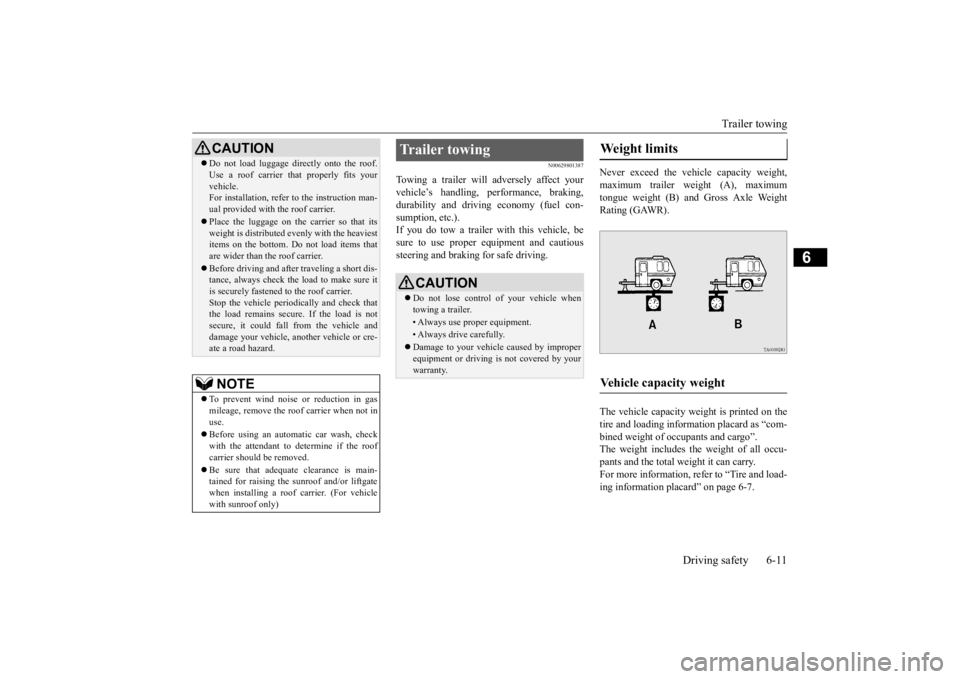
Trailer towing
Driving safety 6-11
6
N00629801387
Towing a trailer will adversely affect your vehicle’s handling, performance, braking,durability and driving economy (fuel con- sumption, etc.). If you do tow a trailer with this vehicle, besure to use proper equipment and cautious steering and braking for safe driving.
Never exceed the vehicle capacity weight, maximum trailer weight (A), maximum tongue weight (B) and Gross Axle WeightRating (GAWR). The vehicle capacity weight is printed on the tire and loading information placard as “com- bined weight of occupants and cargo”.The weight includes the weight of all occu- pants and the total weight it can carry. For more information, refer to “Tire and load-ing information placard” on page 6-7.
CAUTION Do not load luggage directly onto the roof. Use a roof carrier th
at properly fits your
vehicle. For installation, refer to the instruction man- ual provided with the roof carrier. Place the luggage on the carrier so that its weight is distributed evenly with the heaviestitems on the bottom. Do not load items that are wider than the roof carrier. Before driving and after traveling a short dis- tance, always check the load to make sure it is securely fastened to the roof carrier.Stop the vehicle periodically and check that the load remains secure. If the load is not secure, it could fall from the vehicle anddamage your vehicle, another vehicle or cre- ate a road hazard.NOTE
To prevent wind noise or reduction in gas mileage, remove the roof carrier when not in use. Before using an automatic car wash, check with the attendant to determine if the roof carrier should be removed. Be sure that adequate clearance is main- tained for raising the sunroof and/or liftgate when installing a roof carrier. (For vehicle with sunroof only)
Trailer towing
CAUTION Do not lose control of your vehicle when towing a trailer.• Always use proper equipment.• Always drive carefully. Damage to your vehicle caused by improper equipment or driving is not covered by your warranty.
Weight limits Vehicle capacity weight
BK0277700US.bo
ok 11 ページ 2019年3月8日 金曜日 午前9時23分
Page 389 of 427
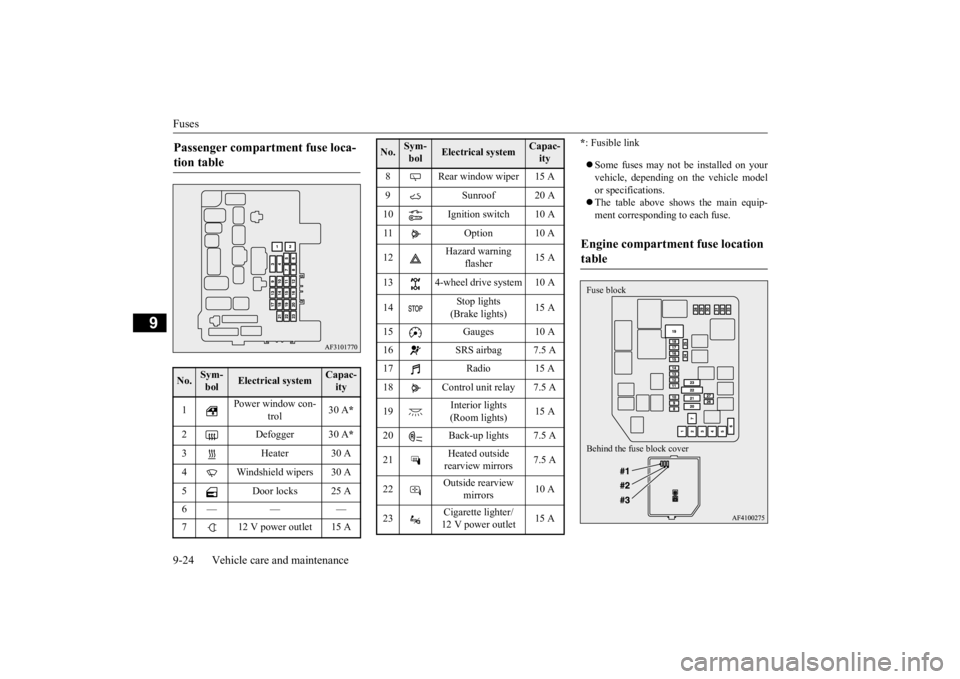
Fuses 9-24 Vehicle care and maintenance
9
* : Fusible link Some fuses may not be installed on your vehicle, depending on the vehicle model or specifications. The table above shows the main equip- ment corresponding to each fuse.
Passenger compartment fuse loca- tion table No.
Sym- bol
Electrical system
Capac-ity
1
Power window con-
trol
30 A
*
2 Defogger 30 A
*
3 Heater 30 A 4 Windshield wipers 30 A 5 Door locks 25 A 6— — — 7 12 V power outlet 15 A
8 Rear window wiper 15 A 9 Sunroof 20 A 10 Ignition switch 10 A 11 Option 10 A 12
Hazard warning
flasher
15 A
13 4-wheel drive system 10 A14
Stop lights (Brake lights)
15 A
15 Gauges 10 A 16 SRS airbag 7.5 A 17 Radio 15 A 18 Control unit relay 7.5 A 19
Interior lights (Room lights)
15 A
20 Back-up lights 7.5 A21
Heated outside rearview mirrors
7.5 A
22
Outside rearview
mirrors
10 A
23
Cigarette lighter/ 12 V power outlet
15 A
No.
Sym- bol
Electrical system
Capac-ity
Engine compartment fuse location table Behind the fuse block cover Fuse block
BK0277700US.bo
ok 24 ページ 2019年3月8日 金曜日 午前9時23分
Page 402 of 427
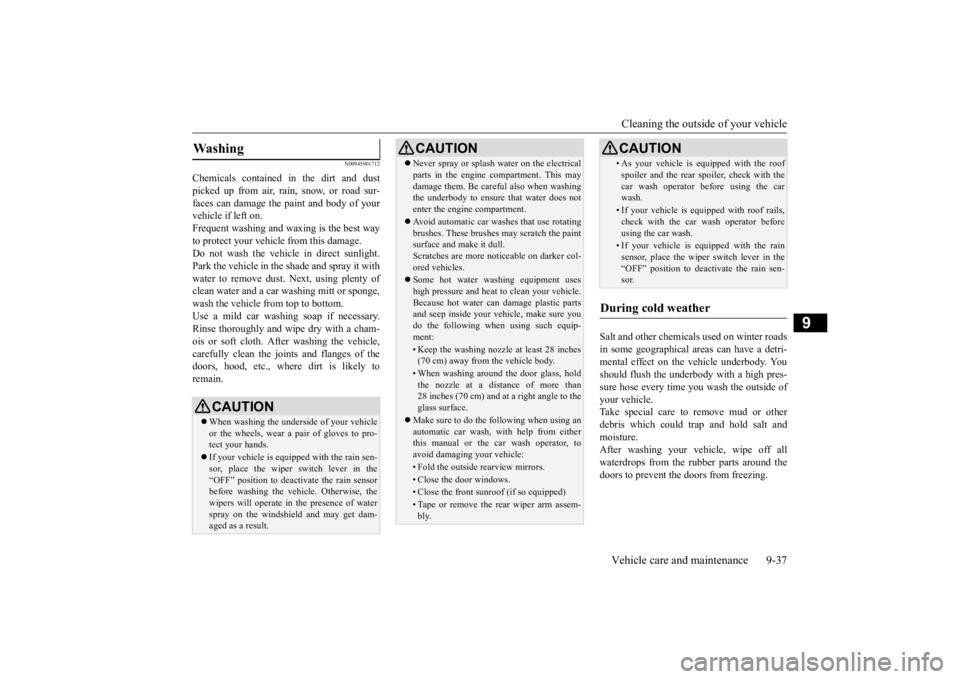
Cleaning the outside of your vehicle Vehicle care and maintenance 9-37
9
N00945901712
Chemicals contained in the dirt and dust picked up from air, rain, snow, or road sur-faces can damage the paint and body of your vehicle if left on. Frequent washing and waxing is the best wayto protect your vehicle from this damage. Do not wash the vehicle in direct sunlight. Park the vehicle in the shade and spray it withwater to remove dust. Next, using plenty ofclean water and a car washing mitt or sponge, wash the vehicle from top to bottom. Use a mild car washing soap if necessary.Rinse thoroughly and wipe dry with a cham- ois or soft cloth. After washing the vehicle, carefully clean the joints and flanges of thedoors, hood, etc., where dirt is likely to remain.
Salt and other chemicals
used on winter roads
in some geographical areas can have a detri- mental effect on the vehicle underbody. You should flush the underbody with a high pres-sure hose every time you wash the outside of your vehicle. Take special care to remove mud or otherdebris which could trap and hold salt and moisture. After washing your vehicle, wipe off allwaterdrops from the rubber parts around the doors to prevent the doors from freezing.
Wa s h i n g
CAUTION When washing the underside of your vehicle or the wheels, wear a pair of gloves to pro-tect your hands. If your vehicle is equipped with the rain sen- sor, place the wiper switch lever in the “OFF” position to deactivate the rain sensorbefore washing the vehicle. Otherwise, the wipers will operate in the presence of water spray on the windshield and may get dam-aged as a result.
Never spray or splash water on the electrical parts in the engine compartment. This may damage them. Be careful also when washing the underbody to ensure that water does not enter the engine compartment. Avoid automatic car washes that use rotating brushes. These brushes may scratch the paintsurface and make it dull. Scratches are more noticeable on darker col- ored vehicles. Some hot water washing equipment uses high pressure and heat
to clean your vehicle.
Because hot water can damage plastic parts and seep inside your vehicle, make sure you do the following when using such equip-ment:• Keep the washing nozzle at least 28 inches(70 cm) away from the vehicle body.• When washing around the door glass, holdthe nozzle at a distance of more than 28 inches (70 cm) and at a right angle to the glass surface.
Make sure to do the following when using an automatic car wash, with help from eitherthis manual or the car wash operator, to avoid damaging your vehicle:• Fold the outside rearview mirrors.• Close the door windows.• Close the front sunroof (if so equipped)• Tape or remove the rear wiper arm assem- bly.CAUTION
• As your vehicle is equipped with the roof spoiler and the rear spoiler, check with the car wash operator before using the car wash.• If your vehicle is equipped with roof rails,check with the car wash operator before using the car wash.• If your vehicle is equipped with the rainsensor, place the wiper switch lever in the“OFF” position to deactivate the rain sen- sor.
During cold weather
CAUTION
BK0277700US.bo
ok 37 ページ 2019年3月8日 金曜日 午前9時23分
Page 403 of 427
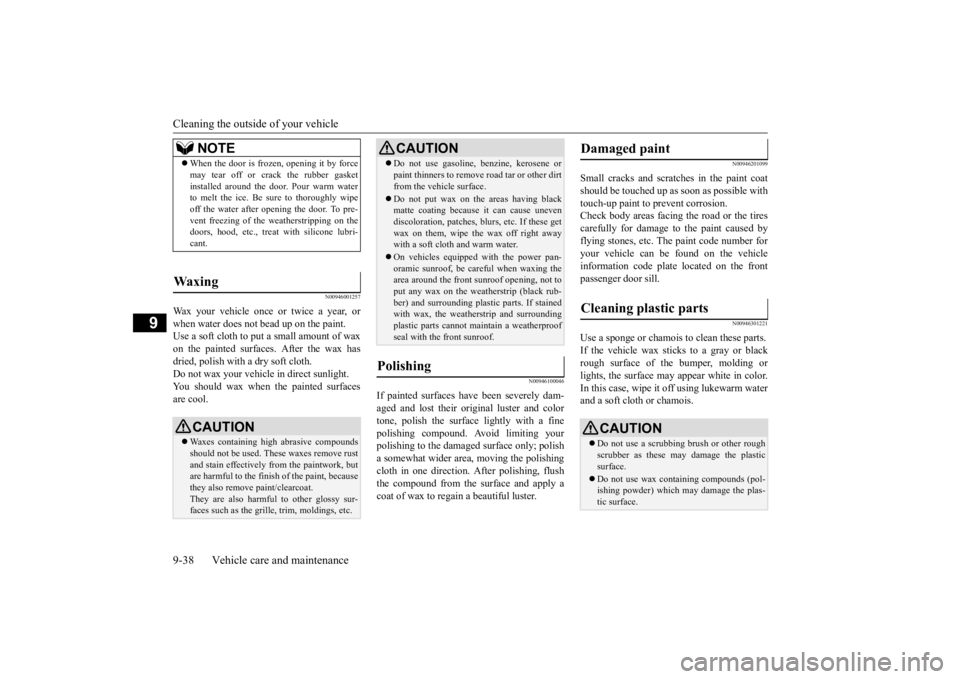
Cleaning the outside of your vehicle 9-38 Vehicle care and maintenance
9
N00946001257
Wax your vehicle once or twice a year, or when water does not bead up on the paint. Use a soft cloth to put a small amount of wax on the painted surfaces. After the wax hasdried, polish with a dry soft cloth. Do not wax your vehicle in direct sunlight. You should wax when the painted surfacesare cool.
N00946100046
If painted surfaces have been severely dam- aged and lost their original luster and color tone, polish the surface lightly with a finepolishing compound. Avoid limiting your polishing to the damaged surface only; polish a somewhat wider area, moving the polishingcloth in one direction. After polishing, flush the compound from the surface and apply a coat of wax to regain a beautiful luster.
N00946201099
Small cracks and scratches in the paint coatshould be touched up as soon as possible withtouch-up paint to prevent corrosion. Check body areas facing the road or the tires carefully for damage to the paint caused byflying stones, etc. The paint code number for your vehicle can be found on the vehicle information code plate located on the frontpassenger door sill.
N00946301221
Use a sponge or chamois to clean these parts.If the vehicle wax sticks to a gray or blackrough surface of the bumper, molding or lights, the surface may appear white in color. In this case, wipe it off using lukewarm waterand a soft cloth or chamois.
NOTE
When the door is frozen, opening it by force may tear off or crack the rubber gasket installed around the door. Pour warm water to melt the ice. Be sure to thoroughly wipe off the water after opening the door. To pre-vent freezing of the weatherstripping on the doors, hood, etc., treat
with silicone lubri-
cant.
Waxing
CAUTION Waxes containing high abrasive compounds should not be used. These waxes remove rust and stain effectively from the paintwork, butare harmful to the finish of the paint, because they also remove paint/clearcoat. They are also harmful to other glossy sur-faces such as the grill
e, trim, moldings, etc.
Do not use gasoline, benzine, kerosene or paint thinners to remove road tar or other dirt from the vehicle surface. Do not put wax on the areas having black matte coating because it can cause uneven discoloration, patches, blurs, etc. If these get wax on them, wipe the wax off right awaywith a soft cloth and warm water. On vehicles equipped with the power pan- oramic sunroof, be careful when waxing the area around the front sunroof opening, not to put any wax on the weatherstrip (black rub-ber) and surrounding plastic parts. If stained with wax, the weatherstrip and surrounding plastic parts cannot maintain a weatherproofseal with the front sunroof.
Polishing
CAUTION
Damaged paint Cleaning plastic parts
CAUTION Do not use a scrubbing brush or other rough scrubber as these may damage the plastic surface. Do not use wax containing compounds (pol- ishing powder) which may damage the plas-tic surface.
BK0277700US.bo
ok 38 ページ 2019年3月8日 金曜日 午前9時23分
Page 404 of 427
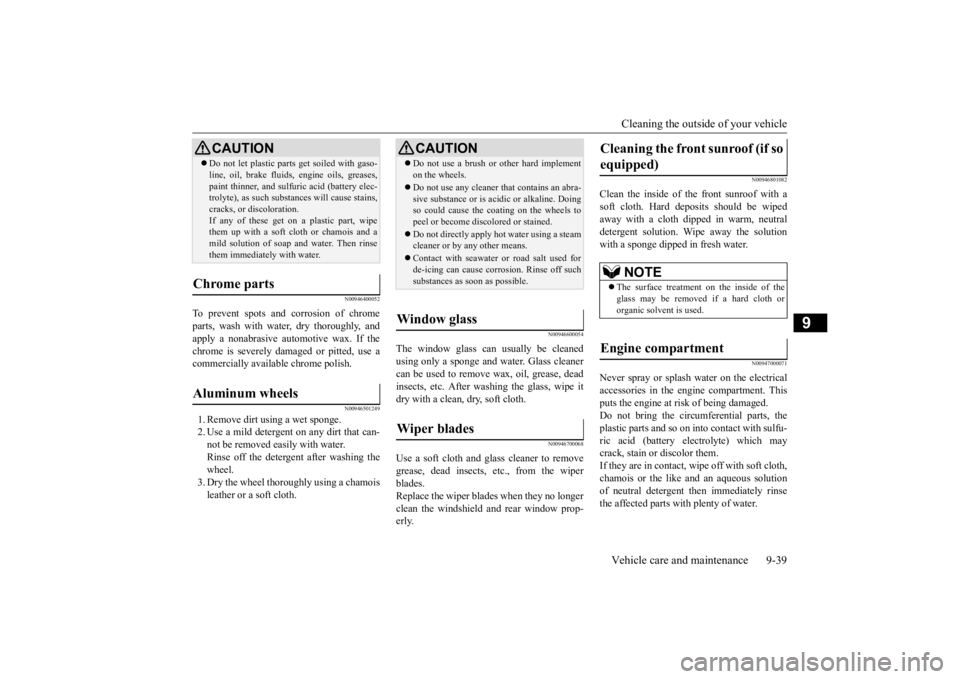
Cleaning the outside of your vehicle Vehicle care and maintenance 9-39
9
N00946400052
To prevent spots and corrosion of chrome parts, wash with water, dry thoroughly, and apply a nonabrasive automotive wax. If thechrome is severely damaged or pitted, use a commercially available chrome polish.
N00946501249
1. Remove dirt using a wet sponge.2. Use a mild detergent on any dirt that can- not be removed easily with water.Rinse off the detergent after washing the wheel. 3. Dry the wheel thoroug
hly using a chamois
leather or a soft cloth.
N00946600054
The window glass can usually be cleanedusing only a sponge and water. Glass cleaner can be used to remove wax, oil, grease, dead insects, etc. After washing the glass, wipe itdry with a clean, dry, soft cloth.
N00946700068
Use a soft cloth and glass cleaner to removegrease, dead insects, etc., from the wiper blades. Replace the wiper blades when they no longerclean the windshield and rear window prop- erly.
N00946801082
Clean the inside of the front sunroof with a soft cloth. Hard deposits should be wiped away with a cloth dipped in warm, neutral detergent solution. Wipe away the solutionwith a sponge dipped in fresh water.
N00947000071
Never spray or splash water on the electricalaccessories in the engine compartment. This puts the engine at risk of being damaged. Do not bring the circumferential parts, theplastic parts and so on into contact with sulfu- ric acid (battery electrolyte) which may crack, stain or discolor them.If they are in contact, wipe off with soft cloth, chamois or the like and an aqueous solution of neutral detergent then immediately rinsethe affected parts with plenty of water.
Do not let plastic parts get soiled with gaso- line, oil, brake fluids
, engine oils, greases,
paint thinner, and sulfuric acid (battery elec- trolyte), as such substances will cause stains, cracks, or discoloration.If any of these get on a plastic part, wipe them up with a soft cloth or chamois and a mild solution of soap and water. Then rinsethem immediately with water.
Chrome parts Aluminum wheels
CAUTION
CAUTION Do not use a brush or other hard implement on the wheels. Do not use any cleaner that contains an abra- sive substance or is acidic or alkaline. Doingso could cause the coating on the wheels to peel or become discolored or stained. Do not directly apply hot water using a steam cleaner or by any other means. Contact with seawater or road salt used for de-icing can cause corrosion. Rinse off such substances as soon as possible.
Window glass Wiper blades
Cleaning the front sunroof (if so equipped)
NOTE
The surface treatment on the inside of the glass may be removed if a hard cloth or organic solvent is used.
Engine compartment
BK0277700US.bo
ok 39 ページ 2019年3月8日 金曜日 午前9時23分